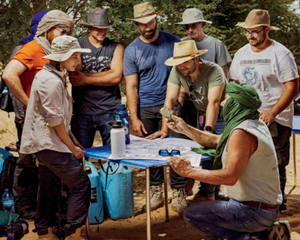These burials seem to be communicating something about the deceased. When excavating a grave, archaeologists usually disarticulate skeletons if they plan to take them to a lab.
這些墳墓似乎要傳達關于死者的某種信息。挖掘墳墓時,如果考古學家打算把骸骨帶回實驗室,通常會將它拆解開來。
Sereno wanted to preserve the most important and unusual Gobero figures in their striking poses, so he employed a technique paleontologists use to preserve dinosaur fossils.
塞雷諾想要把最重要、最不尋常的格伯托遺骸以原有的奇特姿勢保存下來,因此采用了古生物學家用來保存恐龍化石的一種技術。
He dug trenches around some of the most interesting burials and encased them in plaster, allowing the team to remove them in situ for transportation back to his lab.
他在最有趣的一些墓葬周圍挖掘溝槽,用石膏把它們包裹起來,讓研究團隊能以原狀移動它們,運回他的實驗室。
Excavating human remains is a highly sensitive subject, but there's a compelling case to be made for studying the Gobero burials in a modern lab.
挖掘人類遺骸是非常敏感的議題,不過要在現代的實驗室研究格伯托的墓葬有很重要的理由。
The bones contain volumes of information, says Chris Stojanowski, a professor at Arizona State University who was part of the 2006 expedition.
克里斯·斯托賈諾夫斯基是亞利桑那州立大學的教授,也是2006年遠征隊成員,他說這些骨頭包含大量信息。
He's been studying skeletons collected on that trip ever since.
從2006年起,他就一直研究那次遠征收集的骸骨。
"You see all this?" he said to me recently on Zoom, tilting his camera to reveal stacks of books and papers. "It's all Gobero research."
“你看見這些了嗎?”他最近在一次Zoom訪談中對我說,并傾斜鏡頭讓我看見成堆的書籍和論文。“這全是格伯托的研究。”
Stojanowski analyzes skeletal remains to understand how humans interacted with their environment, what diseases they suffered, telltale signs of their lifestyle left on their bones and teeth.
斯托賈諾夫斯基分析遺骸,以了解這些人類與環境如何互動、他們罹患什么疾病、留在他們骨頭和牙齒上的痕跡所透露的生活方式。
One of the most surprising things was how few injuries he found. One person had a skull fracture but had survived, because it had fully healed.
有件事非常令人驚訝,那就是他找到的傷痕非常少。有個人的頭骨破裂,但活下來了,因為頭骨已經完全愈合。
Then there was a woman who'd suffered a wound to her fibula that also had healed. Embedded in the bone were rock fragments consistent with what an arrowhead would leave.
有名女子的腓骨受過傷,也痊愈了。骨頭里嵌入了一些碎巖石,與箭頭會留下的碎片吻合。
"Otherwise," Stojanowski said, "there's no real signs of violence that I can see."
“除了這些之外,”斯托賈諾夫斯基說,“我沒有看到真正的暴力跡象。”
They also don't seem to have been under significant stress from starvation, drought, or chronic illness.
他們似乎也沒有因為饑餓、干旱或慢性病而承受明顯壓力。

As teeth form, they accumulate microscopic layers of enamel -- like how trees add new growth rings -- and periods of high stress, including trauma, are recorded by disruptions in the layers.
牙齒形成時會累積一層層的釉質,就像樹木增加年輪;而壓力大的時期,包括受到創傷,則會造成釉質層中斷而留下紀錄。
Hoping to shed light on the triple burial, Stojanowski had molars from the two children thin-sliced and reviewed microscopically; the results revealed no evidence of significant stress.
斯托賈諾夫斯基希望多了解埋著新生兒母子與少年的三人墓葬,于是將兩名孩童的臼齒做很薄的切片,再用顯微鏡觀察;結果沒找到明顯承受壓力的證據。
Another revelation was the people didn't seem to move from place to place.
另一項發現是這些人似乎沒有到處遷徙。
With nomadic individuals, you can trace their movements by matching the signature of the strontium isotopes in their teeth -- accrued from the plants and animals they ate and the water they drank -- with the strontium in the bedrock at the places they visited.
若要追溯游牧民族個體的活動,可以比較牙齒的鍶同位素特征(由他們吃的動植物和喝的水累積形成)以及他們所到之處巖床里的鍶元素。
But the people Stojanowski has studied at Gobero show primarily one signature. "They didn't really move much."
但斯托賈諾夫斯基研究的格伯托居民,呈現的鍶同位素特征主要是同一種。“他們沒有移動太遠。”
Sereno has found other evidence that implies people lived year-round at Gobero. His teams have collected otoliths, the bony structures from the inner ears of fish.
塞雷諾還發現了別的證據,顯示有人常年住在格伯托。他的團隊收集到耳石,這是魚類內耳的骨質構造。
Like layers of enamel in teeth, otoliths grow in tiny rings, adding a new one each season.
就像牙齒的層層釉質,耳石會呈小小的環圈生長,每一季加上新的一圈。
The outermost ring suggests when a fish was caught. The otoliths found in Gobero's middens indicate the fish were caught throughout the year.
最外側的一圈表示一只魚遭到捕捉的時間。在格伯托的貝冢找到的耳石,顯示這里全年都在捕魚。
One of the biggest surprises was that out of the thousands of animal bones found at the site, only a single cow bone has been identified.
最令人驚奇之處在于遺址找到的數千件動物骨頭中,鑒定出的牛骨只有一件。
Why would a herding culture like the Tenereans not show more evidence of cows?
像特內里安人這樣的游牧文化,為何沒有出現更多牛類的證據?
Sereno believes the answer may simply be that the people who lived at Gobero weren't herders or nomads.
塞雷諾認為,答案可能很單純,就是格伯托的居民并非放牧或游牧民族。
"Practically everything they needed was at Gobero, and they adapted their lifestyle specifically to this place."
“他們需要的所有東西都在格伯托,他們調整生活方式以適應這個地方。”












